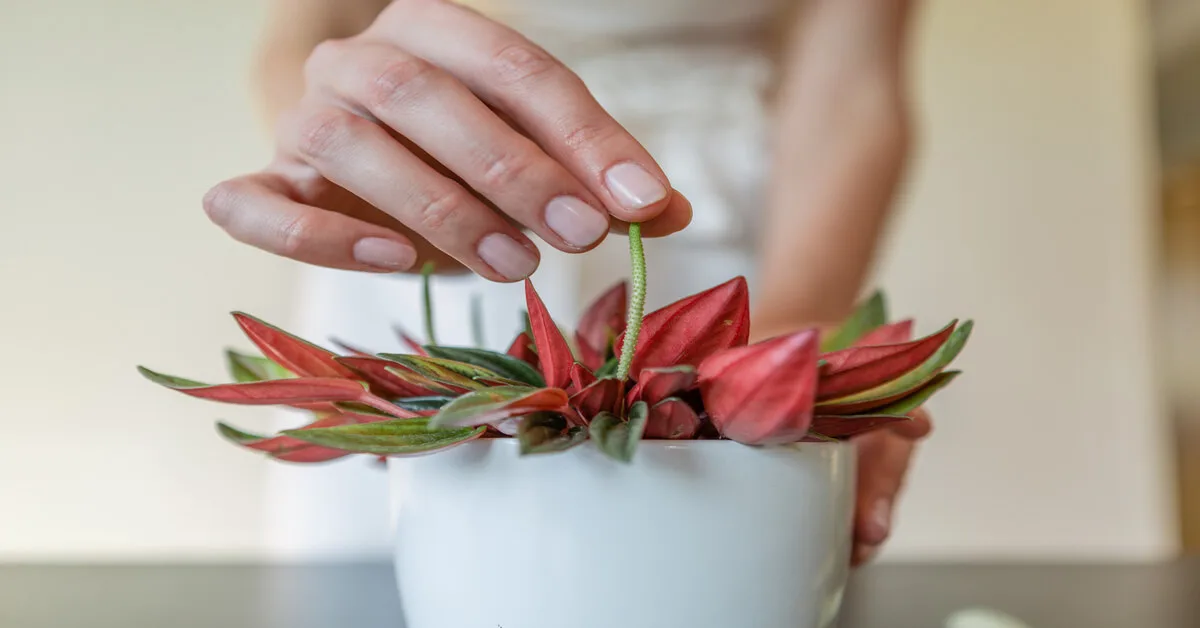Peperomia Rosso (Peperomia caperata ‘Rosso’) is a mound-forming perennial in the Piperaceae family. It is also known as Emerald Ripple and Radiator Plant. Peperomia Rosso reaches a mature size of about 8 inches tall and 8 inches wide.
It has succulent leaves that are dark green on the surface with red to burgundy undersides. They have large vertical corrugations across the leaves which is how they got the name, Emerald Ripple. Peperomia caperata originated in Brazil and many varieties have now been developed.
This article will detail exactly how to grow Peperomia Rosso successfully. We’ll also explain some of its benefits and uses, and provide a list of other popular Peperomia species.
Peperomia Rosso Care

Peperomia Rosso is relatively easy to care for. The biggest issues most people have are with overwatering or underwatering. Avoid watering issues by using the correct soil and checking for moisture before watering.
They are susceptible to a few common indoor houseplant insect pests. Check them regularly to avoid significant insect damage. Otherwise, these plants are pretty easy to keep healthy and happy indoors.
Soil
Peperomia Rosso needs well-draining, moisture-retentive soil that is acidic to grow best. An orchid mix is perfect for peperomia. You can purchase a premade mix or create your own.
Equal amounts of peat moss, perlite, and pine bark will make the perfect growing medium for your Emerald Ripple. The peat moss will help retain moisture while the pine bark allows for good drainage.
Planting Peperomia Rosso in a clay pot will also help keep the soil from retaining too much water.
Watering
Thanks to their succulent leaves, Radiator Plants don’t need much water. They store water in their leaves allowing them to go a little longer than other plants without water. In fact, over-watering can actually cause the leaves to drop or the roots to develop root rot.
Most Peperomia Rosso plants only need water every other week. However, indoor temperatures and humidity can affect how often they need water. Check to make sure the top two inches of soil are dry before adding more water.
Lighting
To grow well, Emerald Ripple needs moderate to bright indirect sunlight. Too little sunlight will result in poor growth and leaf drop. Direct sunlight can cause the succulent leaves to burn and turn brown.
Humidity & Temperature
Temperatures between 60 and 80 degrees Fahrenheit are best for Peperomia Rosso. It doesn’t tolerate temperatures that dip below 55 degrees Fahrenheit well.
Warmer temperatures allow these plants to thrive. Growing them on the warmer end of their preferred range will allow them to grow larger and produce more flowers[1].
This tropical plant prefers higher humidity as well. Humidity levels that hover around 75% are optimal. However, they will do fine at lower humidity levels between 40 and 60%.
Fertilizing
Fertilizer isn’t needed for growing healthy Emerald Ripple plants. These slow-growing epiphytes can get all of the nutrients they need from an orchid potting mix.
Propagation
Stem cuttings are the best way to propagate your Radiator Plant. Cut the end of one of the mother plant’s stems off ¼ inch above the last leaf you’ll leave on it. The stem cutting should have at least 1 leaf on it.
Plant the cutting in a small pot placed in a location with bright, indirect light. Keep the soil moist, but not soaked, for at least 4 weeks to allow roots to grow. After about 8 weeks, you safely transplant your new plant into a larger pot.
Diseases & Pests
Root rot is the most common disease of Peperomia Rosso. If you have well-draining soil and don’t overwater you shouldn’t have this problem.
Insects that will infest Emerald Ripple plants include mealybugs, spider mites, and whiteflies[2]. Make sure you check plants for insects every time you water them. The quicker you notice insect pests, the easier they are to get rid of.
Toxicity
Peperomia Rosso is safe to grow in homes with children and pets. It is not toxic to humans, cats, and dogs.
Benefits & Uses of Peperomia Rosso
Peperomia Rosso improves indoor air quality by increasing oxygen and decreasing carbon dioxide. It can also filter out formaldehyde from the air.
Peperomia Rosso is a great indoor plant. You can also use it outside if you live in USDA hardiness zones 10 or higher. It needs to be placed in a location that won’t get direct afternoon sun.
Other Popular Peperomia Varieties
- Peperomia alata
- Peperomia angulata
- Peperomia argyreia
- Peperomia albovittata
- Peperomia blanda
- Peperomia clusiifolia
- Peperomia ferreyrae
- Peperomia graveolens
- Peperomia griseoargentea
- Peperomia Moonlight
- Peperomia obtusifolia
- Peperomia orba
- Peperomia pellucida
- Peperomia polybotrya
- Peperomia prostrata
- Peperomia puteolata
- Peperomia rotundifolia
- Peperomia scandens
- Peperomia Silver Frost
- Peperomia tetraphylla
- Peperomia wheeleri
References:
[1] Brøndum, J. J., & Friis, K. (1990). The influence of temperature and photoperiod on the flowering of Peperomia caperata Yuncker. Scientia horticulturae, 41(3), 259-263.
[2] Peperomia caperata. North Carolina Extension Gardener Plant Toolbox. North Carolina State University.

